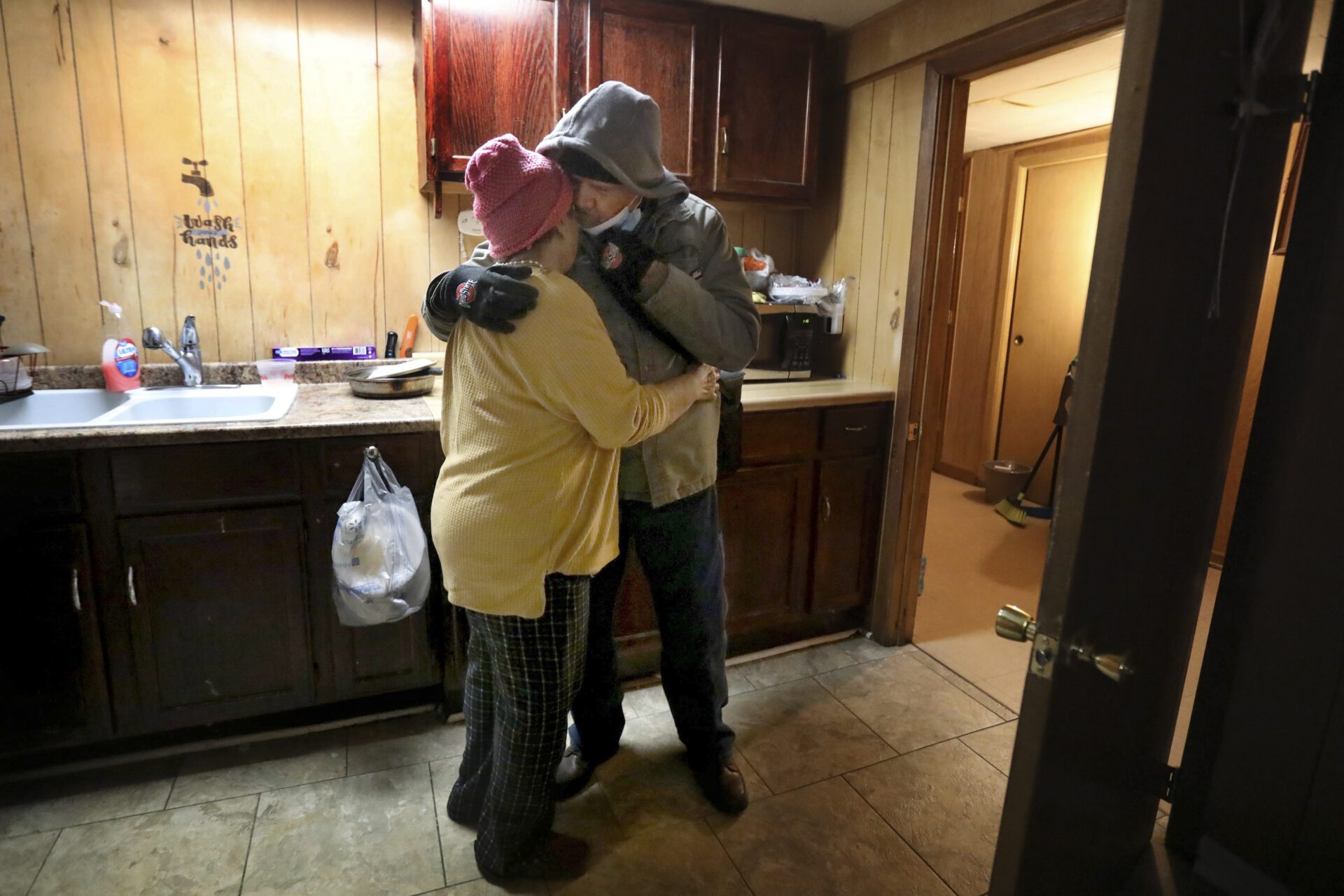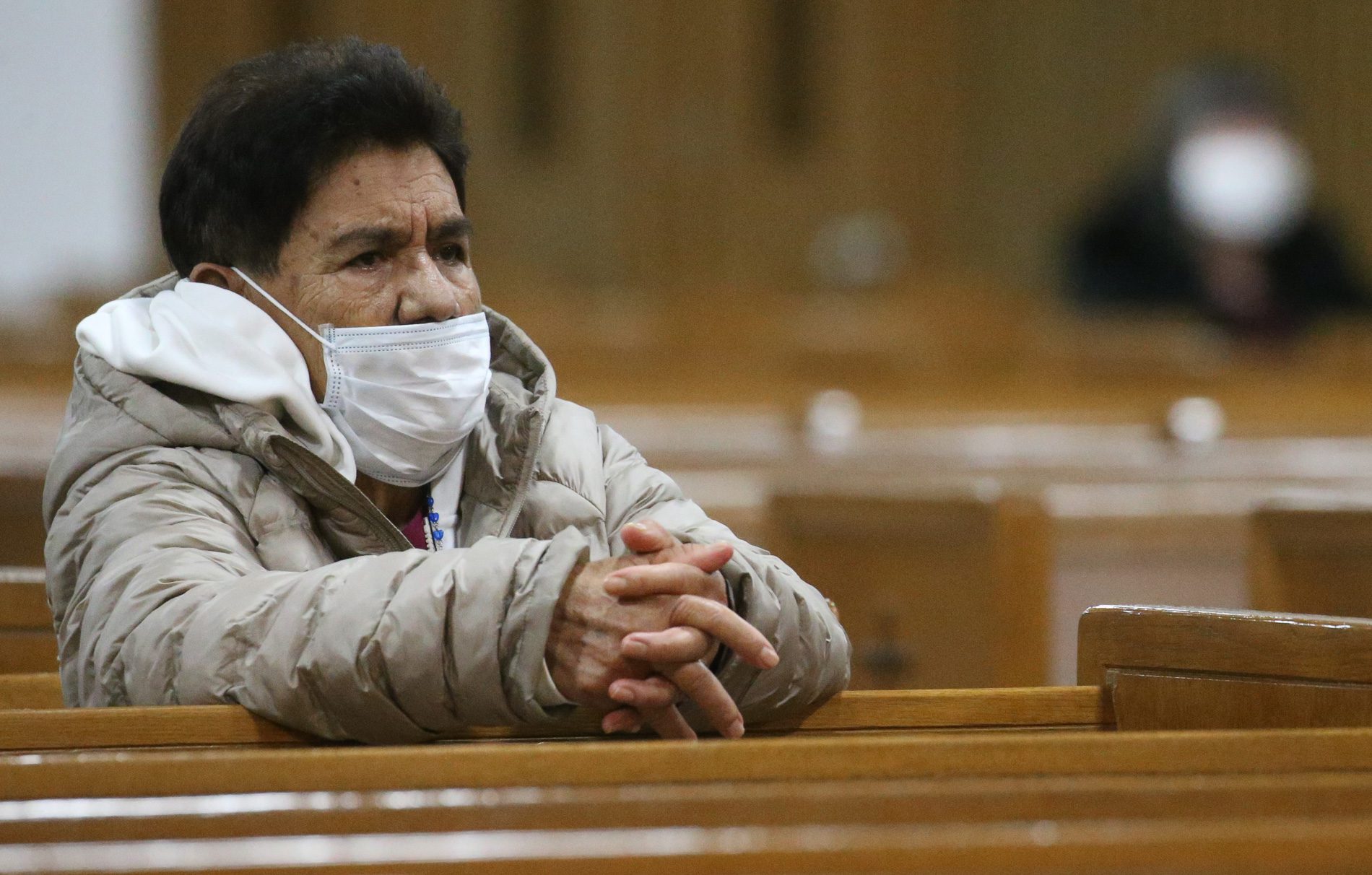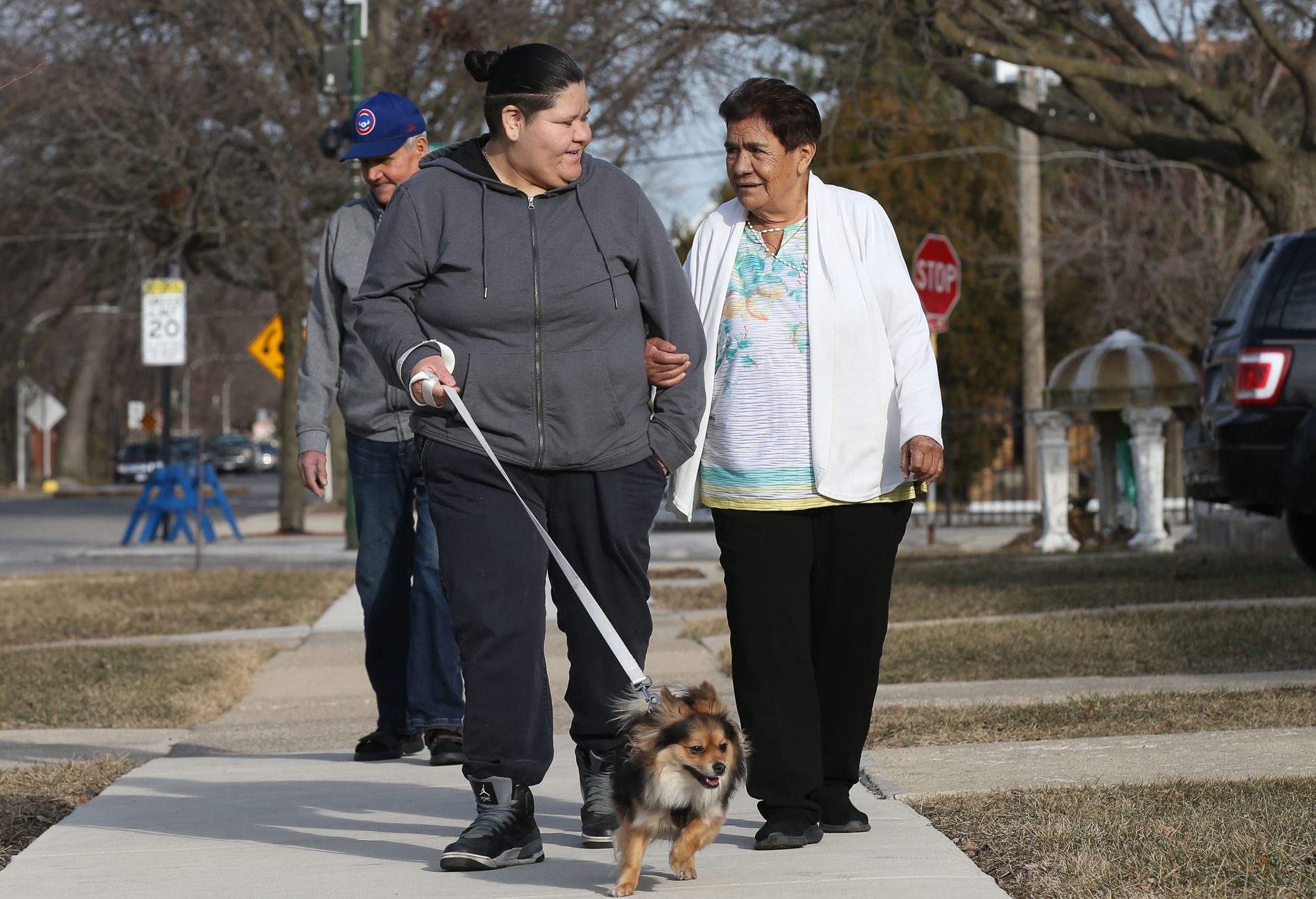 Photo by Antonio Perez/Chicago Tribune
Photo by Antonio Perez/Chicago TribuneThe number of undocumented immigrants ages 65 and over in Illinois is set to grow exponentially. Advocates say it’s a crisis in the making. Injustice Watch and the Chicago Tribune teamed up to report on the challenges facing Illinois’ aging undocumented population.
Injustice Watch and The Chicago Tribune teamed up to report on the challenges facing Illinois’ aging undocumented population. This is the first installment in a four-part series, “Aging in the Shadows,” focused on access to health care and housing.
In a cold basement apartment on the Southwest Side, Gregorio Pillado and Martina Alonso count pennies and pray for relief.
Pillado, 79, has been working at a nearby meatpacking plant for 20 years, lifting thousands of pounds of frozen meats into large vats, eight hours a day, five days a week. His $16 an hour pretax is the married couple’s only source of income. With it, they manage to pay for their groceries, medicines, utilities and their $800 monthly rent — but not much else.
Want to receive stories like this in your inbox every week?
Sign up for our free newsletter.

Alonso, 69, used to bring in money by catering small parties and selling bags of chopped-up nopales (prickly pear), but she had to stop after she fell and injured her wrist months ago.

Pillado’s health has declined dramatically over the last few years. First he had to get a pacemaker implanted. Then he had surgery to remove a hernia. Now he has another hernia, but he doesn’t know whether he’ll be able to get it removed. His health problems make him incapable of handling his old workloads, and he worries about if — or when — he’ll get fired.
“Ya no tengo la misma fuerza y energía que antes.” I don’t have the same strength or energy as I once did, Pillado said.
“Se me quita el sueño cuando me pongo a pensar en qué pasaría si Gregorio perdiera su trabajo.” Alonso said she loses sleep ruminating over what would happen if her husband of 50 years lost his job.
Pillado and Alonso have no savings, no retirement plan and no authorization to live in the U.S.
They’re far from alone. There are at least 3,900 undocumented immigrants age 65 and older living in Illinois. But by 2030, the number of undocumented seniors in the state will top 55,000 — a 1,300% increase in just a decade, according to a report published by Rush University Medical Center last year.

Most undocumented immigrants arrived in the country decades ago and have lived here without a viable pathway to citizenship. Mexican immigrants will make up two-thirds of the undocumented older adult populations in Illinois, followed by immigrants from Eastern Europe, Eastern and Southeastern Asia, and Central America.
Now, this generation of immigrants faces the prospect of having lived and died in the shadows. Undocumented immigrants are blocked from accessing social programs that many seniors rely on, such as food stamps, public housing, Medicare and Social Security Insurance — programs that they pay billions of dollars into every year. Their families and communities weave a patchwork of formal and informal resources to make up the difference.

“The social cost for families of these older adults not having access to services that they desperately need is huge,” said Padraic Stanley, a program coordinator and social worker at Rush and one of the report’s lead authors.
Without a social safety net, many undocumented seniors are forced to work until they drop, said Adela Carlin, a public aid lawyer who’s helped dozens of immigrants in the Chicago area access charity funds. “When you’re undocumented, there’s no such thing as a retirement age,” she said. “You work until you can’t anymore.”
‘There was no future there for us’
Pillado and Alonso’s story mirrors that of many other undocumented seniors in Illinois. The couple immigrated to Chicago with their younger daughter, Rocio Pillado, then a teenager, in 2000. They came to Illinois at the tail end of a three-decades-long massive Mexican migration wave that’s been in sharp decline since 2008. The couple’s elder daughter had already come to Chicago a few years prior, and their only son stayed in Mexico to raise his own family.
Immigrating from Mexico to the U.S. without breaking the law was impossible for the family. Without a family member who’s a citizen, an employer to sponsor their green card applications, or a credible fear of persecution in Mexico that would qualify them for asylum, there was no legal pathway for Pillado, Alonso and Rocio to move to the U.S. The same goes for migrants without a sponsor or asylum case from China, Pakistan, Nigeria or any other country that has had 50,000 or more residents immigrate to the U.S. in the past five years.
“Queríamos una casa bien bonita,” said Alonso. They wanted to build a small house in their hometown, a dim prospect if they had stayed in Mexico.

Before they immigrated, Pillado, who never received a formal education, sold churros on the street while Alonso worked on and off at warehouses and factories. “There was no future there for us,” Alonso said.
The family hired coyotes to help them cross the border illegally. Pillado came first, hoping to secure a job, but he was quickly apprehended and detained by immigration officers. When they hadn’t heard from Pillado for months, Alonso and Rocio made their way to the border, hoping to reconnect with him on the other side. But immigration officials had deported Pillado back to Mexico. When he found out his family had left for the U.S., he crossed the border again as quickly as he could. He wasn’t caught the second time. “I came back for my family,” he said.
Under current immigration law it’s nearly impossible for the family to legalize its status — especially for Pillado, whose prior deportation puts him on the fast-track for immediate removal from the country if immigration officials apprehend him. And even if Alonso and Rocio managed to get a green card sponsor, they would have to leave the U.S. for at least three years, and up to 10, before being allowed to come back legally — assuming the application even goes through, which in itself takes years to process and often ends up costing thousands of dollars in application fees and lawyers fees.
These roadblocks are rooted in a 1996 law signed by then-President Bill Clinton. In essence, the law — known as the Illegal Immigration Reform and Immigration Responsibility Act — made it harder for people to legally immigrate to the U.S. and made it easier for the federal government to deport them. Many immigration scholars agree that these restrictions incentivized undocumented immigrants to hunker down in the U.S., freezing them in place at the risk of being banished from the country.
So, in Chicago, that’s what Pillado, Alonso and Rocio did.
Read More of Our Coverage
Read More of Our Coverage
Back up plan? ‘Sell nopales’
It didn’t take Pillado long to secure a job at the meatpacking plant; and Alonso and Rocio found work through temp agencies. They kept expenses low by living together in a small apartment in the Back of the Yards neighborhood. The two-unit building they lived in was owned by a distant family member who lived upstairs. The idea was to pay off the mortgage together and get some equity out of it, so they could return to Mexico to retire.

The three of them lived in the apartment for about seven years, but the house went belly-up during the Great Recession, forcing the family to spend much of its savings on moving and finding a new place to live. Then in 2016, an even greater tragedy hit the family: The couple’s son in Mexico unexpectedly died at age 35, leaving his wife and three children behind.
“Nunca lo volví a ver, es el dolor más grande que tengo,” I never saw him again. It’s the deepest pain I carry, Alonso said. The couple now sends money to their grandchildren in Mexico every time they can — another reason why they keep working into their old age. “Para la escuela o lo que necesiten,” for school or whatever they need, she said.
In the five years since their son’s death, Pillado and Alonso’s dream of returning to their homeland has faded. Without their son to take care of them in Mexico, the couple now depend exclusively on their daughters in their twilight years. Their elder daughter now has two children of her own, meaning that most of the caretaking duties fall on Rocio, 36, who’s also undocumented.
With many social services cut off to undocumented seniors, family members and community organizations are forced to fill in the gaps left by the state. That compounds the historic income and health inequities between undocumented immigrants and citizens, Carlin said. “There’s always been a generational and a racial wealth gap, and so these workers started behind everybody else,” she said. “And they’re not able to catch up by age 65 or 70.”
And research shows that as undocumented immigrants get older, they begin to rely more heavily on their children for basic needs like food and housing, which puts a burden on the next generation. Rob Paral, a Chicago demographer and expert on the state’s immigrant population trends whose research was used in the Rush report, estimates that 70% of undocumented immigrants age 55 and older in Illinois live in multigenerational households, compared with 28% of native-born older adults.
Rocio lived with her parents well into her 30s, moving with them from the two-flat in Back of the Yards to their cramped basement apartment in West Lawn. She put off her own dreams of buying a house to continue to care for them.

When she finally moved into her own apartment with her longtime partner in November, they rented a place a short drive away from her parents’ basement unit. “I felt like I needed to start building my own life. I know that they need me, but I also needed to start doing things on my own,” she said.
But Rocio remains her parents’ primary caretaker. She brings them groceries, helps pay their bills, and takes days off work to take them to their doctor’s appointments. Those trips, which became more frequent over the last few years, eventually cost her a job at a warehouse.
It didn’t take long for Rocio to find a new job. But it quickly dawned on her that at some point soon, her parents won’t be able to work anymore — and that she’s their only lifeline.
Like her parents, Rocio dreams of owning a house, one big enough to fit her and her parents. But she’s unsure how long it’ll take her dream to materialize; she makes less than $20 an hour and is unable to save much at the end of the month. Rocio hopes that Congress provides her and her parents with a viable path to citizenship. But even then, she puts her parents ahead of herself. “Si a mi me pusieran a escoger entre ellos y yo,” If I had to choose between giving citizenship to my parents or me, she said, “yo diría ellos.” I would say to them.
For now, the family’s plan is for Pillado to keep working and for Alonso to start cooking again — if she recovers. And if Pillado loses his job, “pues a hacer lucha con los nopales,” Alonso said with a half smile. Sell nopales, I guess, she said.

Bring power to immigrant voices!
Our work is made possible thanks to donations from people like you. Support high-quality reporting by making a tax-deductible donation today.
